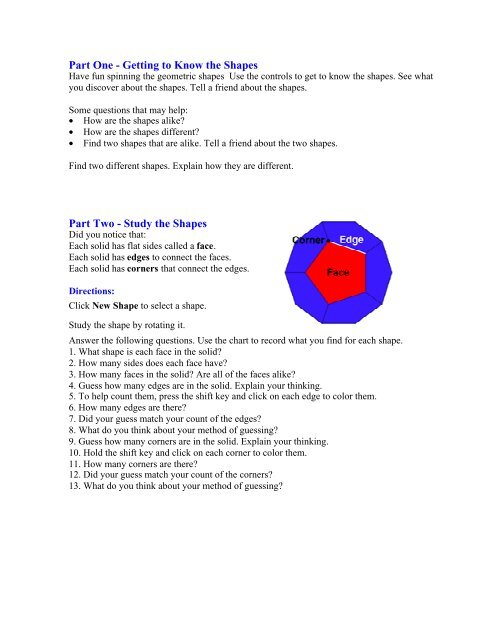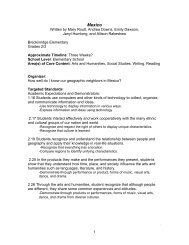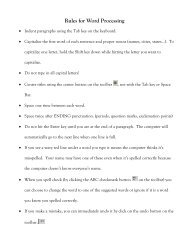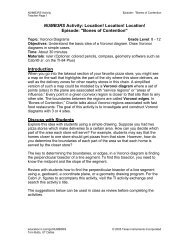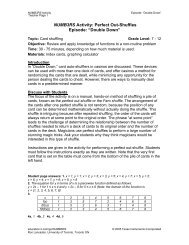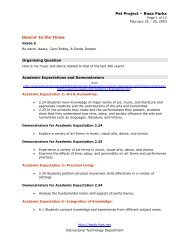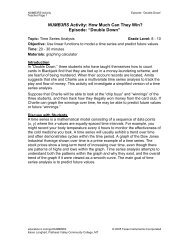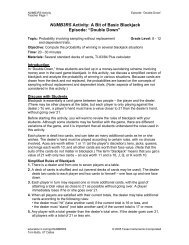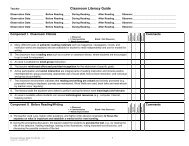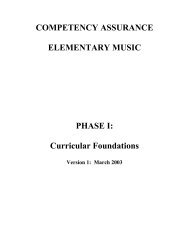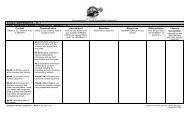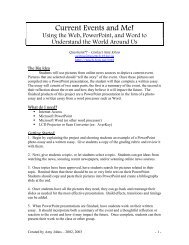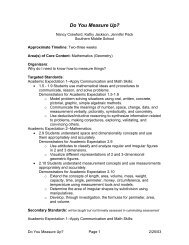Part One - Getting to Know the Shapes Part Two - Study the Shapes
Part One - Getting to Know the Shapes Part Two - Study the Shapes
Part One - Getting to Know the Shapes Part Two - Study the Shapes
Create successful ePaper yourself
Turn your PDF publications into a flip-book with our unique Google optimized e-Paper software.
<strong>Part</strong> <strong>One</strong> - <strong>Getting</strong> <strong>to</strong> <strong>Know</strong> <strong>the</strong> <strong>Shapes</strong>Have fun spinning <strong>the</strong> geometric shapes Use <strong>the</strong> controls <strong>to</strong> get <strong>to</strong> know <strong>the</strong> shapes. See whatyou discover about <strong>the</strong> shapes. Tell a friend about <strong>the</strong> shapes.Some questions that may help:• How are <strong>the</strong> shapes alike?• How are <strong>the</strong> shapes different?• Find two shapes that are alike. Tell a friend about <strong>the</strong> two shapes.Find two different shapes. Explain how <strong>the</strong>y are different.<strong>Part</strong> <strong>Two</strong> - <strong>Study</strong> <strong>the</strong> <strong>Shapes</strong>Did you notice that:Each solid has flat sides called a face.Each solid has edges <strong>to</strong> connect <strong>the</strong> faces.Each solid has corners that connect <strong>the</strong> edges.Directions:Click New Shape <strong>to</strong> select a shape.<strong>Study</strong> <strong>the</strong> shape by rotating it.Answer <strong>the</strong> following questions. Use <strong>the</strong> chart <strong>to</strong> record what you find for each shape.1. What shape is each face in <strong>the</strong> solid?2. How many sides does each face have?3. How many faces in <strong>the</strong> solid? Are all of <strong>the</strong> faces alike?4. Guess how many edges are in <strong>the</strong> solid. Explain your thinking.5. To help count <strong>the</strong>m, press <strong>the</strong> shift key and click on each edge <strong>to</strong> color <strong>the</strong>m.6. How many edges are <strong>the</strong>re?7. Did your guess match your count of <strong>the</strong> edges?8. What do you think about your method of guessing?9. Guess how many corners are in <strong>the</strong> solid. Explain your thinking.10. Hold <strong>the</strong> shift key and click on each corner <strong>to</strong> color <strong>the</strong>m.11. How many corners are <strong>the</strong>re?12. Did your guess match your count of <strong>the</strong> corners?13. What do you think about your method of guessing?
ShapeName of FaceNumber ofSides onEach FaceNumber ofFacesNumber ofCornersNumber ofEdgesDodecahedronIcosahedronOctahedronTetrahedronIrregular PolyhedronCube<strong>Part</strong> Three - Looking for PatternsLook at <strong>the</strong> first shape in <strong>the</strong> table that you made.1. Find <strong>the</strong> sum of <strong>the</strong> number of faces and <strong>the</strong> number of corners.2. How does this sum compare with <strong>the</strong> number of edges?3. Do you think this may be a rule for <strong>the</strong> o<strong>the</strong>r shapes?4. Add <strong>the</strong> number of faces and number of corners for <strong>the</strong> o<strong>the</strong>r shapes in <strong>the</strong> table.5. Compare # of Faces + # of Corners with <strong>the</strong> # of Edges.6. What did you find out? Is <strong>the</strong>re a rule for all of <strong>the</strong> shapes?
<strong>Part</strong> Four - Construct a SolidTask 1:Now work with a partner and construct one or more of <strong>the</strong> shapes out of coffee stirrers andtwist ties, straws and pipe cleaners, <strong>to</strong>othpicks and gumdrops, or o<strong>the</strong>r available supplies.When you make a solid, look at one like it on <strong>the</strong> computer. Record how you constructed eachsolid in <strong>the</strong> table below.Task 2:Build a solid shape of your own. Record your shape and information about it in <strong>the</strong> twoprevious tables.ShapeHow did you construct <strong>the</strong> shape?DodecahedronIcosahedronOctahedronTetrahedronIrregular PolyhedronCube
<strong>Part</strong> Five - Making a Shape JacketIf you were going <strong>to</strong> make jackets <strong>to</strong> fit on each shape, what would <strong>the</strong>y look like?Look at <strong>the</strong>se two jackets. Which solid do you think <strong>the</strong>y will fit on?Jacket #1Jacket #21 - A jacket for a geometric solid that can be folded <strong>to</strong> create <strong>the</strong> surface of <strong>the</strong> solid is called anet. A net is a way of representing a polyhedron in two dimensions.2 - Work with a partner. Look at <strong>the</strong> cube . Plan how you will make a net for a cube.Use graph paper <strong>to</strong> make your net. Fold your net <strong>to</strong> create a cube.3 - Make nets for o<strong>the</strong>r solids.
Choose a Shape:Rotate <strong>the</strong> Shape:Color <strong>the</strong> Shape:Instructions for using <strong>the</strong> shape spinner:Click on <strong>the</strong> new shape but<strong>to</strong>n.Place <strong>the</strong> mouse pointer on <strong>the</strong> shape. Move <strong>the</strong> mouse while holdingdown <strong>the</strong> mouse but<strong>to</strong>n.Click on a color. Hold <strong>the</strong> Shift Key while clicking <strong>the</strong> mouse whereyou want <strong>to</strong> paint. You can paint a face, an edge or a corner.Click on <strong>the</strong> reset shape but<strong>to</strong>n.Remove <strong>the</strong> Color:See Through <strong>the</strong> Shape: Click <strong>the</strong> box by Transparent.Change Shape Size: Use <strong>the</strong> mouse <strong>to</strong> move <strong>the</strong> blue lever.
<strong>Getting</strong> <strong>to</strong> <strong>Know</strong> <strong>the</strong> <strong>Shapes</strong>The questions are open-ended, so answers will vary. Some sample answers are givenbelow."How are <strong>the</strong> shapes alike?"All have many sides; <strong>the</strong> sides are flat. Three of <strong>the</strong> solids are made of triangles."How are <strong>the</strong> shapes different?"The number of flat sides is different; <strong>the</strong> flat sides of one of <strong>the</strong> shapes (<strong>the</strong> irregularpolyhedron) are different shapes…
The Student Worksheet contains a blank chart that students can fill in. A completedchart is shown below.ShapeName ofFaceNumberof Sideson EachFaceNumberof FacesNumberofCornersNumberofEdgeson <strong>the</strong>SolidTetrahedron triangle 3 4 4 6Cube square 4 6 8 12Octahedron triangle 3 8 6 12Dodecahedron pentagon 5 12 20 30Icosahedron triangle 3 20 12 30IrregularPolyhedronsquares &trapezoids4 10 12 20
Looking for Patterns1.Find <strong>the</strong> sum of <strong>the</strong> number of faces and corners of <strong>the</strong> first shape (12 + 20 = 32)2.How does this sum compare with <strong>the</strong> number of edges? ( The number of edges is 2less, or <strong>the</strong> sum is 2 more than <strong>the</strong> number of edges.)3. Do you think this may be a rule for <strong>the</strong> o<strong>the</strong>r shapes? (student discussion)4. Add <strong>the</strong> number of faces and <strong>the</strong> number of corners of o<strong>the</strong>r shapes::Shape Faces + Corners EdgesTetrahedron 4 + 4 = 8 6Cube 6 + 8 = 14 12Octahedron 8 + 6 = 14 12Dodecahedron 12 + 20 = 32 30Icosahedron 20 + 12 = 32 30IrregularPolyhedron10 + 12 = 22 205.Compare <strong>the</strong> sum of faces and corners <strong>to</strong> <strong>the</strong> number of edges. (Students shouldnotice that F + C is 2 more than E. Students may express this pattern in different ways.)6. What did you find out? What's <strong>the</strong> rule? (Let students come up with <strong>the</strong> rule.)


